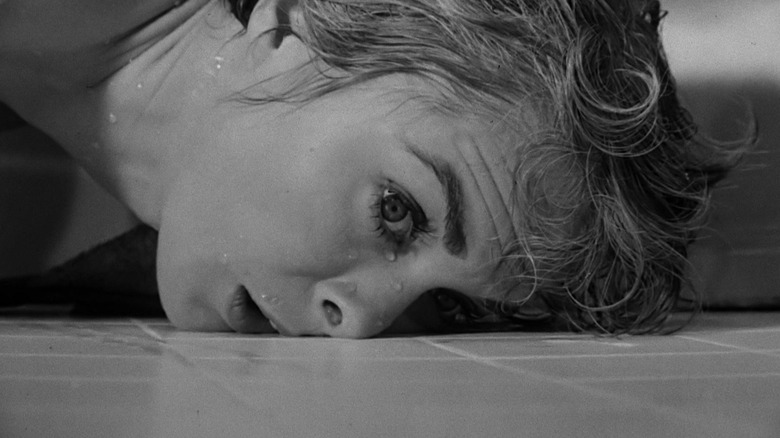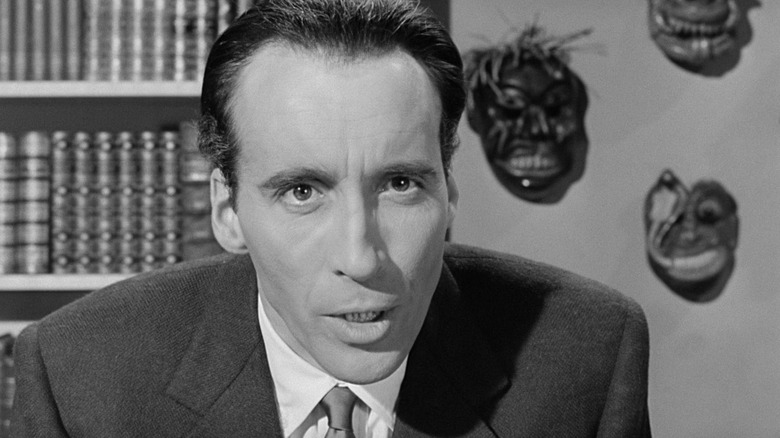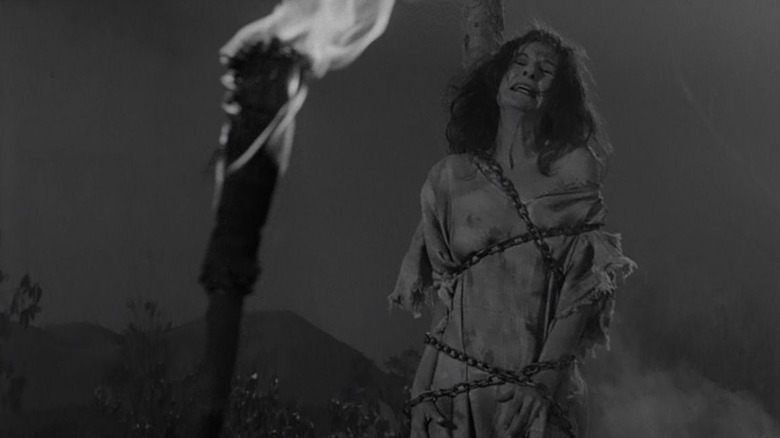This 60s Horror Movie Had The Same Twist As Psycho
I'm sure you all know the famous, then-shocking twist of Alfred Hitchcock's "Psycho." Marion Crane (Janet Leigh) is set up as the film's protagonist; the opening scene is an intimate moment between her and lover Sam Loomis (John Gavin), who can't commit until he pays his debts. So, she impulsively steals $40,000 from her boss' client. Surely the movie will be about her on the run.
Well, it is for a while, but then she makes it to the Bates Motel. She chats up polite young innkeeper Norman (Anthony Perkins), but his elderly mother (only heard, never seen) sure seems creepy. With an hour to go, Marion is murdered by a knife-wielding assailant in the motel shower (a scene so scary it left Leigh scared of showers). The film's second half becomes a new story about Sam and Marion's sister Lila (Vera Miles) investigating her disappearance. They stumble onto the truth — that Marion was killed by Norman, possessed by an alternate personality modeled after his mother.
"Psycho" pushed the limits of studio filmmaking, not just in depicting sexuality and violence but in its structure. Killing off your lead (and biggest star) halfway through? If this doesn't seem shocking today, it's only because "Psycho" knocked down the door.
In one of the many coincidences of parallel films throughout Hollywood history, there was another black-and-white horror film released in 1960 with the same structure — a much more obscure one titled "City of the Dead."
City of the Dead
"City of the Dead," directed by John Llewellyn Moxey, was a different kind of horror movie than "Psycho," with the scares coming from the supernatural rather than a serial killer. The film begins in 1692 Massachusetts, where the villagers of Whitewood burn the accused witch Elizabeth Selwyn (Patricia Jessel) — but it's not enough. Thanks to her pact with Lucifer, Sewlyn and her coven will live forever so long as she sacrifices two girls to her lord every year. This ritual is where the double entendre title comes from.
Despite starring Sir Christopher Lee (who famously played Dracula for British horror studio Hammer), "City of the Dead" is a British Lion film, not a Hammer one (the smoky black-and-white is a clear break from Hammer's trademark technicolor too). Lee plays Professor Alan Driscoll, one of Sewlyn's Satanists who's gone out into the world to lure victims back to Whitewood. His latest target? One of his students, Nan Barlow (Venetia Stevenson); Driscoll piques her curiosity with the history of witchcraft and then suggests she travel to Whitewood for some field research.
Nan plays the role of Marion; she checks into Sewlyn's Raven Inn, explores the creepiness of Whitewood, and then at the halfway mark, she's captured and ritually sacrificed. ("City of the Dead" doesn't use frenzied editing to obscure her stabbing like "Psycho" did, but a simple match cut to a knife slamming down on a birthday cake.)
Was Psycho first?
"City of the Dead" is a tight 77 minutes, but a picture that long of just Nan investigating the witches would risk being repetitive. Instead, her death shows the threat is very real. Like "Psycho," the rest of the movie becomes about other characters investigating her disappearance, specifically her boyfriend Bill Maitland (Tom Naylor), her brother Richard (Dennis Lotis), and Whitewood shopkeeper Patricia (Betta St. John). And just like in "Psycho," the audience (privy to the full picture where the characters are not) knows they're all skirting close to danger. (Richard walks in on Professor Driscoll having just sacrificed a bird.)
Milton Subotsky, a producer on "City of the Dead," discusses the similarities to "Psycho" in the book "Amicus: The Studio that Dripped Blood." (Amicus was the horror studio that Subotsky and Max Rosenberg founded after they worked together on "City of the Dead.") Subotsky even asserts, "We did it first," referring to the heroine-dying twist. His self-congratulation doesn't hold up to timeline scrutiny, though; both films were released in September 1960, meaning one couldn't have been inspired by the other.
"Psycho" was always destined to be the bigger film too. By 1960, Hitchcock's reputation as "The Master of Suspense" was ironclad; his movies weren't exactly considered high art yet, but they were events. The cast of "Psycho" was also populated by movie stars — Leigh, Miles, and Perkins — while Christopher Lee was the only member of the "City of the Dead" cast/crew who wasn't obscure.
"City of the Dead" may not be a classic like "Psycho," but it's a fun spookfest that deserves to be seen more.


